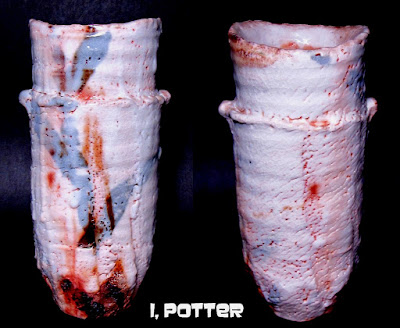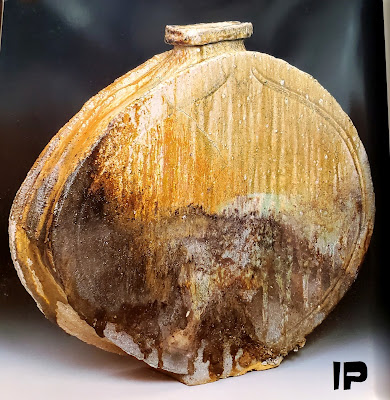As you can see in this vase made by Miraku Kamei XIII there is a streamlined elegance to the form, the superfluous details are cast away relying on the purity of line/form and enticing and intriguing surfaces. By combining oyu (straw yellows) and rokushoyu (green-blue) glazes, Miraku has brought movement and life to a rather simple and stylized form acting almost like floating clouds on a static form pointing to the highly detailed and articulated fish lugs and broad distinct mouth and lip of the pot. As I stated, this is a simple form with intriguing and curious details that are highlighted by a complex surface of movement and subtle painterly qualities that are as timeless as the Takatori tradition now in its 15th generation and moving toward another century of dedication to an ideal and devotion to purpose and ceremony.
Monday, March 31, 2025
FLOATING CLOUDS
Friday, March 28, 2025
ACCOMODATING
Wednesday, March 26, 2025
WHAT IS THE PLURAL OF FLUTE?
This was clearly an end of day
pot, not thought out and just thrown using some clay already wedged up. Obviously,
it was slightly thought out as it was thrown thick enough to flute vertically
and horizontally which interrupts the flow of the movement of the surface. There
is a simple lid surrounded by concentric bands to add so movement and interest
to that as well and completed with a slab impressed handle based on a Cubist
apple stem. The idea to this spur of the moment pot is pretty simple and since a
fluted surface looks good, I went with my Oribe and accents of iron which have
created cascades of color running down the furrows. By the way, what is the
plural of flute in this context, is it as simple as flutes?
Monday, March 24, 2025
NONE THE LESS
Friday, March 21, 2025
WHO?
Wednesday, March 19, 2025
Monday, March 17, 2025
WEE BIT-O-GREEN
Friday, March 14, 2025
OSC REVISITED
A while back I suffered a rather catastrophic computer crash and have been working daily rescuing data from the old computer and recently came across this older slideshow video. I realize I posted a static photo of this Oni-Shino chawan by Hayashi Shotaro previously but thought the group of photos helps fill in the blanks, adds detail and perhaps builds the sense of volume of the piece that a single picture certainly would not. Enjoy!
Wednesday, March 12, 2025
NEXT CYCLE?
The teabowl is glazed over in my temmoku glaze and then was dipped in an iron red that was quickly combed with my fingers before the surface could dry. The effect is a bit obvious where dark tendrils of color mingle with the droozy, running iron which always reminds me a bit of the partridge feather technique. One other feature worth mentioning is that the bowl is punctuated in small, reflective iron crystals that just cover the surface of the glaze, a nice little bonus to the overall runny effect. Every time I come across this picture, it reminds me I need to make a few more of these pots instead of treating them like they are in the rear-view mirror. Maybe next cycle?
Monday, March 10, 2025
JUST ANOTHER VASE
Illustrated is a tall, conservative E-Shino hanaire by Hori Ichiro. Thrown out of a buff, mogusa (?) clay, the casual form shows off its pronounced throwing marks and is sub-divided by a rough and perfectly placed should that defines the body and neck of the pot. The face of the pot was spontaneously decorated with a grasses design which it is clear that Hori has completed countless times before, all leading up to the rather serendipitous glazing where the interplay from thicker to thin and the running Shino all enhance and quite frankly create the rather feudal appearing landscape.
Though just
another vase at some level, the final appearance makes for a rich surface where
the underglaze iron, the purity of the white glaze and the various other cast
of characters work in perfect harmony to make for a Shino vase that to my eye
is quite unique or perhaps idiosyncratic to Hori Ichiro. In thinking about the
general field of the modern Shino tradition, there are a number of potters who
have developed rather unique looks from Kato Kozo to Suzuki Goro with Hori
fitting into that group who have decided to use the past and their inner voice
to unlock the potential of a specific orthodoxy allowing it to be present and
help move it along, one pot and firing at a time. To this task and within the
categories of Ki-Seto, Seto-Guro and Shino, I think few are as up to the
challenge as is Hori Ichiro.
Friday, March 7, 2025
Wednesday, March 5, 2025
COG-WARE
Monday, March 3, 2025
CUSTOM-TAILORED
Though this piece is quite attractive in natural light and incandescent lighting, it clearly comes out of its shell and leaves all inhibitions behind when highlighted by the afternoon sun. Like with a number of potters that are on my short list, I am always looking forward to seeing my next Sasaki piece be it temmoku or Ki-Seto.

ip2.jpg)







ip2.jpg)

ip.jpg)


five.jpg)





